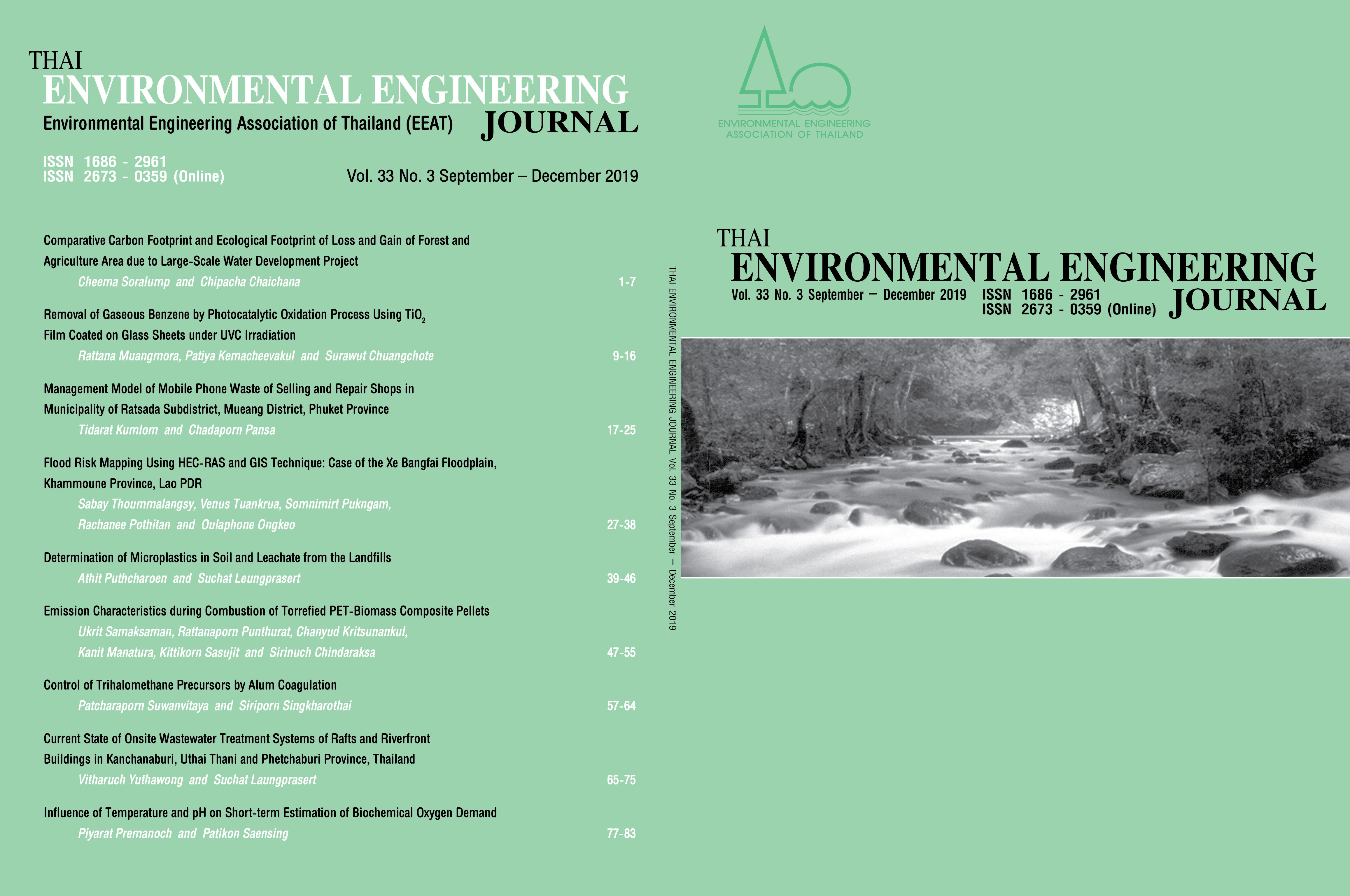Determination of microplastics in soil and leachate from the Landfills
Main Article Content
Abstract
Microplastics (MPs) from soil and leachate at the landfill sites located around the gulf of Thailand were determined. The 12 soil samples and 10 leachates from the landfills were collected and were analyzed by using the density separation technique. The average of MPs from soil samples and leachates were 1457.99±489.71 Items/1Kg.dryweight and 20.90±4.96 Items/1Kg.dryweight, respectively. There are 5 specific plastic shapes, including fibers, films, sphere, granules and irregular were determined from the microplastics. Resulting from Fourier Transform Infrared Spectroscopy (FTIR) analysis is indicated that 3 main types of microplastics from the landfill are Polyethylene (PE), Polypropylene (PP), and Polyethylene Terephthalate (PET). This was confirmed by the types of plastic wastes found in the landfills. As a result, microplastics can occur in the landfill whether the age of the landfills is still young. This research could be concluded that the landfills were one of the main sources for releasing microplastics to the environment. The further study, the degradation rate and the other routes of plastics that may cause microplastics contaminated in the environment will be studied.
Article Details
References
[2] Thompson, R.C., Moore, C.J., vomSaal, F.S., Swan, S.H., 2009. Plastics, the environment and human health: current consensus and future trends. Philos. Trans. R. Soc. B Biol. Sci. 364, 2153-2166.
[3] Avio, C.G., Gorbi, S., Regoli, F., 2017. Plastics and microplastics in the oceans: from emerging pollutants to emerged threat. Mar. Environ. Res. 128, 2-11.
[4] Eriksen, M., Lebretonlc, M., Carsonh, S., et al., 2014. Plastic Pollution in the World’s Oceans: More than 5 Trillion Plastic Pieces Weighing over 250,000 Tons Afloat at Sea. Plos One. 9, e111913.
[5] United Nations Environment Programme, 9 March 2018.
[6] Nelms, S., Galloway, T., Godley, B., Jarvis, D.B., Lindeque, P.K., 2018. Investigating microplastic trophic transfer in marine top predators. Environmental Pollution, Online Early View, 1-9.
[7] Mason, S.A., Garneau, D., Sutton, R., Chu, Y., Ehmann, K., Barnes, J., Fink, P., Papazissimos, D., Rogers, D.L., 2016. Microplastic pollution is widely detected in US municipal wastewater treatment plant effluent. Environ. Pollut. 218, 1045-1054. https://doi.org/10.1016/j.envpol.2016.08.056
[8] Olubukola S. Alimi et al., 2016. Microplastics and Nanoplastics in Aquatic Environments: Aggregation, Deposition, and Enhanced Contaminant Transport. Environ. Sci. Technol. 2018, 52, 4, 1704-1724. https://doi.org/10.1021/acs.est.7b05559
[9] Browne, M.A., Niven, S.J., Galloway, T.S., Rowland, S.J., Thompson, R.C., 2013. Microplastic moves pollutants and additives to worms, reducing functions linked to health and biodiversity. Curr. Biol. 23, 2388-2392.
[10] Thompson, R.C., Olsen, Y., Mitchell, R.P., Davis, A., Rowland, J.S., John, A.W.G., McGonigle, D., Russell, A.E., 2004. Lost at sea: where is all the plastic? Science 304, 838.
[11] Masura, J., Baker, J., Foster, G., Arthur, C., 2015. Laboratory Methods for the Analysis of Microplastics in the Marine Environment: Recommendations for Quantifying Synthetic Particles in Waters and Sediments. NOAA Technical Memorandum NOS-OR&R-48.
[12] Wang, W., Wang, J., Different partition of polycyclic aromatic hydrocarbon on environmental particulates in freshwater: Microplastics in comparison to natural sediment. Ecotoxicol. Environ. Saf. 2017, 147, (Supplement C), 648-655.
[13] Zhu, L., Bai, H., Chen, B., Sun, X., Qu, K., & Xia, B. 2018. Microplastic pollution in North Yellow Sea, China: Observations on occurrence, distribution and identification. Science of the Total Environment, 636, 20-29.
https://doi:10.1016/j.scitotenv.2018.04.182
[14] Wang, W., Ndungu, A. W., Li, Z., & Wang, J. 2017. Microplastics pollution in inland freshwaters of China: A case study in urban surface waters of Wuhan, China. Science of the Total Environment, 575, 1369-1374. https://doi:10.1016/j.scitotenv.2016.09.213
[15] Abidli, S., Toumi, H., Lahbib, Y., & Trigui El Menif, N. 2017. The First Evaluation of Microplastics in Sediments from the Complex Lagoon-Channel of Bizerte (Northern Tunisia). Water, Air, & Soil Pollution, 228(7). doi:10.1007/s11270-017-3439-9.
[16] Gewert, B., Plassmann, M. M., & MacLeod, M. 2015. Pathways for degradation of plastic polymers floating in the marine environment. Environmental Science: Processes & Impacts, 17(9): 1513-1521. doi:10.1039/c5em00207a
[17] Browne, M.A., Underwood, A.J., Chapman, M.G., Williams, R., Thompson, R.C., van Franeker, J.A., 2015. Linking effects of anthropogenic debris to ecological impacts. Proc. Biol. Sci. 282, 20142929.


